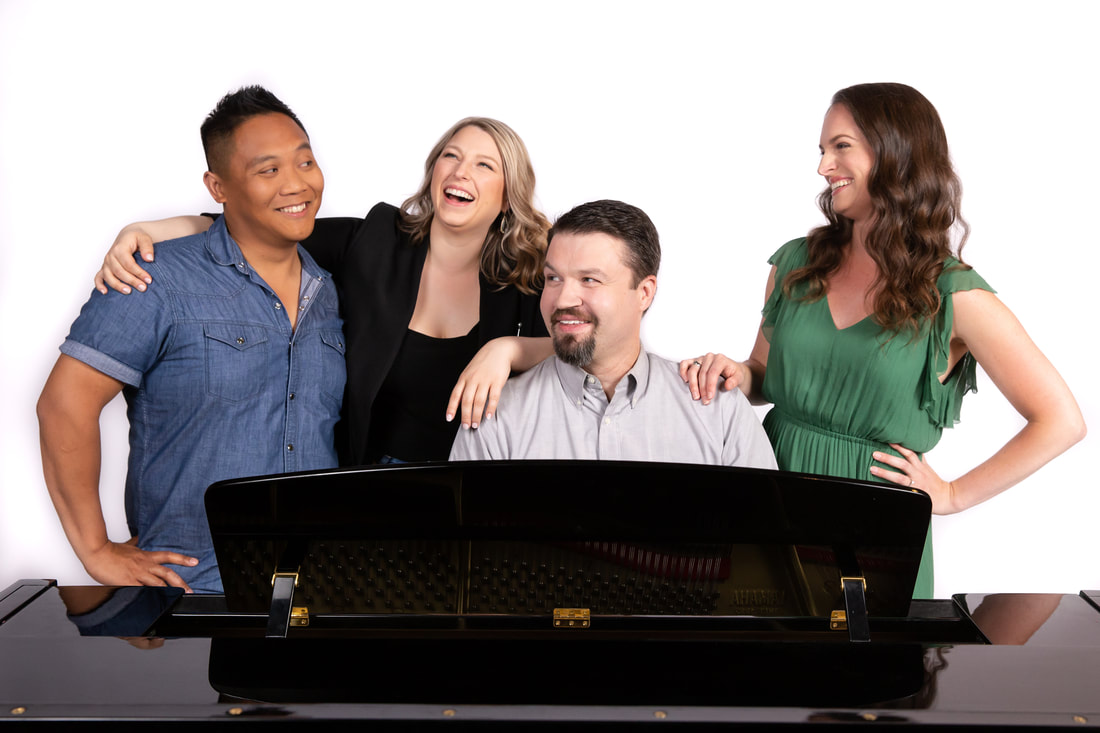|
David: For most singers, the art that we create is a communal experience. The synergy of a choir of voices generates the magic of the music that we love. While the music itself has been conspicuously absent this year, singers have also missed out on countless hours of making music with colleagues who are also dear friends. The pandemic has reminded us not to take friendship for granted, and I have acquired very specific memories of seeing friends for the first time after quarantine. This week on The Art Song Fix we are showcasing "The Pleasures of Friendship" from Wayland Rogers’ I-Thou, a light-hearted celebration of spending time with companions. It has indeed been a pleasure to continue to make music with my Fourth Coast friends! Sarah: This song is one of my favorite movements from I-Thou, a song cycle for vocal quartet commissioned by Fourth Coast and premiered in May 2018. It’s a lively a cappella fugue for the four voices, truly capturing the joy and “Pleasures of Friendship” in the playful way the theme bounces between the voices. After one full statement of the jaunty theme by the soprano, the tenor next presents the melody with interjections bouncing off by soprano and mezzo in duet, followed by a more complete trio version by the three voices. Finally, the bass enters in a new key, infusing new energy into the quartet of friends as they react to one another’s statements. The four voices expand into a flurry of activity before all coming together to end in unified rhythm and a unison note - a beautiful encapsulation of friends joining! Bridget: English poet Stevie Smith's work commonly portrays scenes of innocence and nostalgia, often nursery-rhyme-like on the surface. "The Pleasures of Friendship" is the perfect example of just such a work. However, critics agree that despite the whimsical appearance of her work, Smith was a significant talent whose distinct style grew more consistent and refined throughout her life. The deceptive simplicity of her poetry was described by the Times Literary Supplement as her "most distinctive achievement." Smith's scenes of simple joy remind us that life is short, and every walk through the grass with friends should be savored. Ace: We have done a few of these virtual video performances now, and at this point, the whole process of recording and editing feels quite normal to us. We have learned more about audio and video than most classical singers probably dreamed would be so necessary and useful. Still, while standing in a closet alone, singing to a track and click of a metronome and taking video selfies while performing to an imaginary audience no longer feels as awkward and stilted as it did at first, truly nothing can replace the real deal. The quartet is in “hybrid mode” now with a few livestream concerts under our belt, music videos like this, and a return to in-person rehearsals just this past week. It was refreshing to be able to, collectively in real-time, discuss interpretation, how to color and shape phrases, balance our voices, place our cutoffs, etc.—you know, normal music things! The intimacy of making eye contact and breathing together is pulling us out from within the literal and figurative walls that have contained us for the past year. We sense the returning thrill and pressure of having to create something beautiful together in the moment for a live audience, and we cannot wait to share more about the exciting plans we have for the summer and for next season. Stick with us, and stay tuned! AuthorFourth Coast Ensemble is a classical vocal quartet specializing in the unique style and repertoire of vocal chamber music. Celebrated for its "horizon-expanding programming, (Chicago Classical Review), Fourth Coast Ensemble embraces a repertoire that spans the history of the genre, from Schubert and Brahms to composers of the present day. The ensemble has earned a reputation of excellence "built on the quality of its small roster of artists" (Vocal Arts Chicago) - soprano Sarah van der Ploeg, mezzo-soprano Bridget Skaggs, tenor Ace Gangoso, and bass-baritone David Govertsen.
1 Comment
By Ace Gangoso May is a month worth celebrating! This month is Chamber Music Month AND Asian American and Pacific Islander Heritage Month here in the United States. During this past season’s Origin Stories concerts, I was thrilled to explore and share my heritage through some of the music of the Philippines. One of the most fascinating and treasured musical genres of the country is called kundiman. On the surface, kundiman present as songs of longing, courtship, and love, but they have double meaning: the beloved represents not just one person as a love interest, but the Philippines itself and the pride and resilience of its native people. These creations were a means of coping with and challenging the oppressive Spanish colonial rule beginning in 1565 and lasting three centuries.  Chocolate Hills, Philippines. Photo by Jacky Lo. There was an interesting dynamic of resistance, a phenomenon some refer to as “Filipinization”---in a way, a form of “reverse colonization”. Filipinos learned to embrace the educational, social, and cultural practices forced upon them, but utilized them for their own benefit, recreating their own native identity through these foreign mediums. Kundiman songs illustrate this perfectly, adopting the musical idioms of Spanish dances, and scored music in the formal western classical tradition that university-trained musicians know well today. The earliest known iterations of kundiman date back to about 1800, evolving through the century to more broadly resemble art song compositions of Europe. The composer Francisco Santiago (1889-1947) is often hailed as the “father of Kundiman Art Song,” and his 1917 song, simply titled “Kundiman” (sometimes subtitled “Cancion Filipina” or “Anak-Dalita”) is one of the most widely performed of the genre. The poem by Deogracias A. Rosario (1894-1936) is a serenade of one beckoning a love interest to come to the window to accept one’s pleas of love. It carries the characteristics most typical of kundiman: plaintive melodies, abundant tenuto and rubato, ascending tessitura, lush accompaniment, and modulation from minor to parallel major---a simple but effective way of symbolizing the journey from despair to hope. This is the story of my ancestors, but I am sure that the feelings of loss and captivity have been ever-present to all of us this past year. May this music be a beacon of light in the darkness for you as it has been to many.
|
SUBSCRIBEAboutHello, and welcome to the blog! We are Fourth Coast Ensemble, Chicago's classical vocal quartet. Join a different member of our ensemble for insights into our favorite art songs, links to archival and new recordings, and reflections on why we value and continue to come back to this musical medium. We proudly present, your #artsongfix! Archives
June 2023
Categories
All
|



 RSS Feed
RSS Feed
